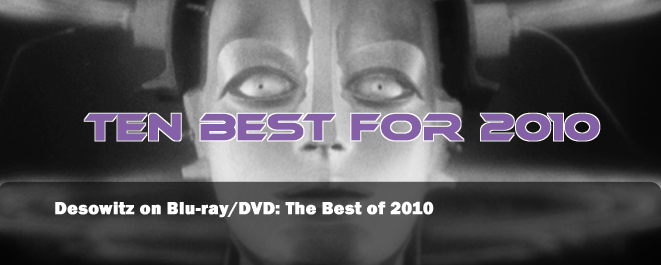THE SCREENING ROOM

DESOWITZ ON BLU-RAY/DVD
By Bill Desowitz
It was a great year for Blu-ray in 2010, with
a lot more releases and greater diversity of films. And it
became even more evident how immersive the 1080p experience is
at home. With greater resolution, sharpness, color saturation,
highlight and shadow detail, it's like watching these films for
the first time, and the DTS-HD Master Audio 5.1 sound only
enhances the experience. Who needs 3-D? There were so many
wonderful pleasures, it's hard to narrow it to 10, but here
goes:
1. Avatar Extended Collector's
Edition (Fox Home Ent.)
It's no surprise that last year's
game-changer from James Cameron translates into this year's
reference quality Blu-ray event as well. Avatar was
made for Blu and not only because it's the color of Pandora. The
sci-fi epic looks and sounds spectacular on the home system, and
the extended collector's edition offers three different versions
of the film, including the extended cut with 16 additional
minutes. I prefer the theatrical version, but it's nice to see
the Sturmbeest hunt and the school house sequences. And the
DTS-HD Master Audio 5.1 can't be beat for a modern presentation.
2. Apocalypse Now
(Lionsgate Home Ent.)
Francis Ford Coppola's trippy
3. Metropolis
(Kino/Eureka)
The long-awaited complete version of Fritz
Lang's 1927 masterpiece was one of the year's highlights. I got
my copy from
4. The Leopard (The
Criterion Collection)
Luchino Visconti's sumptuous feast from 1963
is considered The Gone with the Wind of Italian cinema
and was tailor-made for Blu-ray; it's one of Criterion's
wondrous offerings for 2010. Burt Lancaster (dubbed for the
Italian version) plays the majestic Prince Don Fabrizio Salina,
who is part of the dying aristocracy in Sicily of the 19th
century, trying to hold on to the past with dignity while his
world is destroyed by democratic fervor. Cinematographer
Giuseppe Rotunno creates a rich visual language comprised
principally of yellows, greens, blues, reds and browns. Rotunno
supervised the HD digital transfer, which was created from the
original 35mm 8-perf negative, with the original aspect ratio of
2.21:1. It contains an Italian LPCM 1.0 audio track. The
American version, also included, is 2.35:1, with an English
Dolby Digital 1.0 track.
5. The Thin Red Line
(The Criterion Collection)
This is another stellar Criterion offering --
reference quality, to be sure. Some might prefer Terrence
Malick's Days of Heaven, which Criterion also released
this year, but in terms of sheer aesthetic beauty, this is a far
richer experience. Adapted from the James Jones novel about lost
souls in
6. Doctor Zhivago
(Warner Home Video)
One of the best restorations of the year
makes this 1965 crowd-pleaser a beauty to behold on Blu-ray.
David Lean's visually poetic adaptation of Boris Pasternack's
Nobel Prize-winning novel about the obliteration of love and
individuality during the Russian Revolution is a delicate
balancing act between intimate and epic filmmaking. Lean wasn't
allowed to shoot in 65mm and 70mm blow up prints never did
Freddie Young's Oscar-winning cinematography justice (an
uncredited Nicolas Roeg shot the early funeral and some other
scenes). However, the Blu-ray makes the film look breathtaking,
thanks to Warner Bros. Motion Picture Imaging. Reds and yellows
really pop. Think of the sunflowers and wheat fields and Julie
Christie's red dress. And, of course, her blue eyes have never
been bluer. Also, the use of purple throughout is a bold
statement. For color reference, they used Lean's personal print,
a dye transfer by Technicolor in the
7. The African Queen
(Paramount Home Ent.)
Another great Warner Bros. MPI restoration
brought color back to The African Queen, the beloved
1951 John Huston romantic adventure shot in Technicolor by the
legendary Jack Cardiff. Sharpness is a real surprise (check out
the freckles on Katharine Hepburn's face and her violet dress
and green hat pin). You really get a sense of the weary warrior
vibe between Hepburn and Humphrey Bogart. Also, the rear
projection during the action scenes on the river never looked
right, but now the water looks translucent and the backgrounds
come through quite nicely. Overall, it looks very warm and
golden and green, whenever appropriate, per
8. Moulin Rouge!
(Fox Home Ent.)
I've been waiting since the inception of
Blu-ray for Baz Luhrmann's frenetic pop cultural mash-up (La
Boheme meets "The Can Can" meets a slew of 20th century pop
standards, set in Paris in 1899). And I wasn't disappointed. The
kitschy, super-saturated musical looks positively radiant in Blu
(with a 2.40:1 aspect ratio), and the DTS-HD Master Audio 5.1
really rocks! This time machine-like portal between the past and
present is pure eye candy: from its silent cinema-style opening
to the wild dance hall exuberance that's like channeling
Toulouse-Lautrec while being on absinthe. Certainly the reddest
of Luhrmann's "Red Curtain" films, it'll put a smile on your
face if you give it a chance.
9. Inception
(Warner Home Video)
Speaking of Inception, the great
theatrical experience of 2010 translates to one of the best
reference quality Blu-ray experiences as well. If anything,
Chris Nolan's mind-bender is even more enjoyable at home, and
not because the plot becomes any clearer but because it becomes
more intimate while still maintaining its thrills. Then again, I
tend to have the same reaction to all of Nolan's films, whose
chilliness melts away in the warmth of my home. In this case,
though, the cerebral puzzle takes on greater emotional resonance
while the technical pyrotechnics look sharp and almost like 3-D
in HD (with an aspect ratio of 2.40:1). The DTS-HD Master Audio
5.1 also blows most everything else away with a bombastic
soundscape, and makes Hans Zimmer's score seem as beguiling as
ever. So watching Cobb lose control of his mind with dreams
folding into reality (and vice versa) was one of the great
cinematic pleasures of 2010.
It was another outstanding year for
London-based
About | Site Index | Contact | Terms & Conditions | Links
